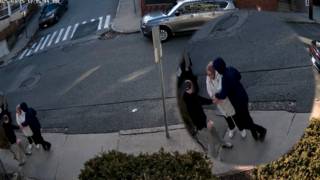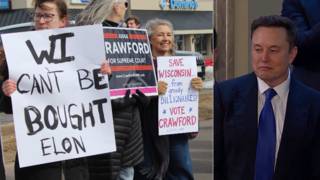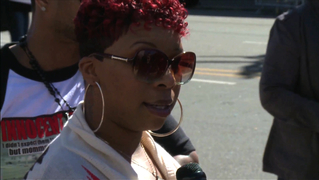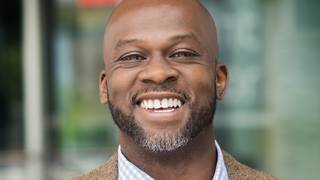
Guests
- James Petersondirector of Africana studies and associate professor of English at Lehigh University. He is also a MSNBC contributor. He is the author of The Hip-Hop Underground and African American Culture: Beneath the Surface.
Responding to the protests in Ferguson and cities nationwide, President Obama has announced several new actions: a new task force to come up with concrete steps for “building public trust” in police forces nationwide; a $263 million “community policing initiative,” which includes $75 million to provide body cameras for around 50,000 police officers; and an executive order that will tighten rules on the provision of military-grade equipment and weapons to local police forces, such as those used in the crackdown on the Ferguson protests. But in a rejection of activists’ demands, Obama vowed to leave the transfers mostly intact. Obama has also sent Attorney General Eric Holder on a tour of communities nationwide. Holder will soon release new federal guidelines to limit racial profiling, but they will not apply to state or local police agencies, such as in Ferguson. We are joined by James Peterson, director of Africana studies at Lehigh University and the author of “The Hip-Hop Underground and African American Culture: Beneath the Surface.”
Transcript
AMY GOODMAN: This is Democracy Now!, democracynow.org, The War and Peace Report. I’m Amy Goodman, with Aaron Maté.
AARON MATÉ: Well, as we continue to talk about Ferguson, I want to turn back to President Obama. On Monday, he reflected on previous federal efforts to address police brutality. Obama said this time will be different because he’s personally invested in change.
PRESIDENT BARACK OBAMA: Part of the reason this time will be different is because the president of the United States is deeply invested in making sure that this time is different. When I hear the young people around this table talk about their experiences, it violates my belief in what America can be.
AMY GOODMAN: That’s President Obama at the White House yesterday, having meetings around police-community relations and the militarization of police. We’re joined now by James Peterson, director of Africana studies and associate professor of English at Lehigh University, author of The Hip-Hop Underground and African American Culture: Beneath the Surface.
Welcome to Democracy Now!, Professor Peterson. Can you respond to how President Obama is dealing with this crisis in Ferguson?
JAMES PETERSON: Well, I think it’s interesting. I think people found his original responses to the crisis somewhat lacking. And the pressure of the people, all of these organized, strategic instances of civic unrest, the die-ins, the different marches and the different sort of ways in which these things are organized across the nation, demand and really command a certain kind of response from the office of the president, and so I think that was the response that you saw yesterday. And obviously, there’s a couple of pieces here that I think are important—one, for him to hear people out, to hear the activists on the ground.
Note well here: The president is well aware of the challenges that young people of color and poor people face in certain communities with police forces that are charged with protecting and serving them, but ultimately end up containing and terrorizing them. So, he’s aware of that. But this is important political theater for him, because the pressure from the public is what creates space for this administration to move on something like this, and I think that’s why you see the policy initiative, some $260 million for community policing, although, I think we’ve got to kind of dig deep and see exactly what that training is going to be like.
And as you pointed out earlier in the earlier segment, even though we can see changes at the federal level, a lot of these problems are operating at the state level and at the municipal level. And so, although the feds can be a model, we are going to need more oversight and a sort of what I refer to as a radical re-ordering of what local law enforcement looks like, in order to see some justice out of some of these instances that we’ve been dealing with over the last several years, actually.
AARON MATÉ: I want to hone in on some of President Obama’s rhetoric and get your response. When he talks about issues of racial injustice, it seems like it’s often framed in this language of a subjective emotional experience. In his comments on Monday, I counted the word “feel” four times.
JAMES PETERSON: A lot of feeling, that’s right.
AARON MATÉ: He says, “Young people of color do not feel as if they’re being treated fairly … young people feeling marginalized,” instead of as an actual reality. Does this language minimize the actual reality of what’s happening?
JAMES PETERSON: Well, I don’t want to minimize the affective nature of these things. It is about how people feel—that’s important—but that’s not strong enough language, in my opinion, because the reality is, a young black person, as a teenager, is 21 times more likely to be murdered at the hands of police. And that’s just from the data that we have. That’s not a full accounting of the data; that’s just the data that we have access to—21 times more likely to be murdered than his or her white counterparts. That’s not a feeling. Those are actual facts. There is data. We have all of these sort of cases that have risen to the level of international sort of media attention, everything from Michael Brown, Tamir Rice, Eric Garner. We can go back into the years and look at other instances of this and see certain names bubble up to the surface. So you have that sort of sensational data, but beneath the surface of that, there are hundreds, if not thousands, of these kinds of cases that don’t rise to that level of attention. And so, that’s actual data.
People are dying at the hands of law enforcement, and that’s not even taking into account the data that we know around stop-and-frisk, around police stops, period, about police brutality and police harassment. It doesn’t take into account a full range of other unfortunate situations when we look at the contact between police forces and the communities with which they’re charged to protect. And so, there’s real data here. This is not just about how people feel. That’s not to minimize people’s feelings about it, but I think to just talk about the affect is not enough to get at the hardcore data that sort of underwrites all these issues and problems that we’re wrestling with.
AMY GOODMAN: On Monday, President Obama said his new task force will come up with concrete recommendations on building public trust in police forces nationwide.
PRESIDENT BARACK OBAMA: They are going to co-chair a task force that is not only going to reach out and listen to law enforcement, community activists, other stakeholders, but is going to report to me specifically in 90 days with concrete recommendations, including best practices for communities where law enforcement and neighborhoods are working well together. How do they create accountability? How do they create transparency? How do they create trust? And how can we at the federal level work with state and local communities to make sure that some of those best practices get institutionalized?
AMY GOODMAN: As President Obama is speaking, he is sitting next to Police Chief Charles Ramsey. That’s Charles Ramsey, the commissioner of the Philadelphia Police Department. As the police chief of Washington, D.C., in the 2000s, Ramsey faced criticism for the mass arrests of protesters during the meetings of the International Monetary Fund and World Bank. The Partnership for Civil Justice Fund, a group that brought suits against Ramsey, said, quote, “You’d be hard pressed to find a more inappropriate choice.” Apparently the Philadelphia police were surprised he was named this. They said they hadn’t known about this as he went to Washington, D.C., for these meetings. You’re in Philadelphia, Professor Peterson. Can you talk about your response to Charles Ramsey as a choice?
JAMES PETERSON: Well, one, I don’t think there are any easy solutions here. You know, Chief Ramsey has had an interesting tenure here in the city of Philadelphia. Philadelphia has had its own set of challenges around law enforcement behaving badly. I think for the president’s perspective, he wanted to get a law enforcement officer who had some experience in cities that have had these challenges, just so that he would have the bona fides of having the experience of understanding how do you sort of repair some of these issues and challenges. But, unfortunately, it’s not a strictly law enforcement problem to be solved, right? What Ashley was saying in the previous segment is really, really important here. And again, politicians don’t want to hear this, but there is a longer haul here, the long, hard word of working with things like racial bias. There’s been a new study out on superhumanization bias, which I think really informs some of these issues. And unless that—the trust can’t be rebuilt, unless we’re going to directly—
AMY GOODMAN: Explain what you mean by the “superhumanization bias.”
JAMES PETERSON: Well, there is this—so, there’s racial bias. People make decisions based upon what their perceptions of race are. But there’s new data out around superhumanization bias, where if you go back to the data or the transcript of the grand jury, when you have Darren Wilson referring to Michael Brown as a demon or referring to him as feeling like he was like Hulk Hogan, or if you think about the reporting around the shooting of Tamir Rice, where they felt that he was a 20-year-old, and he’s a 12-year-old kid, that’s what we might refer to as a superhumanization bias, where whites see black people as literally being superhuman, as being able to endure more pain, as being older than they are, stronger than they are, faster than they are, in some instances more evil or more demonic than they are. And unfortunately, those—that kind of bias has had some awful consequences, once it’s really present in an interface between a law enforcement officer and an unarmed civilian.
And so, those are the kind of complex things that any kind of rebuilding of the trust between the police institutions and communities that are charged with serving and protecting—that’s the only way that’s going to happen, is if we start to get to the social science behind some of the ways in which people are acting. Now, obviously, we all suffer from biases. Everyone operates based upon biases. It’s just that it’s much more pronounced when an officer is making a decision between using lethal force and trying to defuse a situation, and they can’t see a person for the full human being that they are.
AARON MATÉ: Professor, a big issue that came out of the Michael Brown case is the role of the grand jury, especially when you have a prosecutor who works often with police, like Bob McCulloch. What reforms, if any, do you want to see on the issue of grand juries investigating cases like these?
JAMES PETERSON: Yeah, just let’s take the federal data: 162,000 cases brought before grand juries, only 11 of those did not result in indictments. When you talk about—when people say this kind of cliché thing, you can indict a ham sandwich with a grand jury, you know, that’s not really an exaggeration. And so, when you look at that data, that is enough to show you what sort of—what the context is. But then when you dial down on some of that, what we’re realizing is, is that it’s almost impossible to get a conviction of a law enforcement officer who murders a civilian while in the line of duty. That’s whites, blacks, whatever. It’s more pronounced because more black folk are being murdered—unarmed black folk are being murdered by law enforcement, but the reality is, is that we’ve got to at least revise the grand jury process for the indictment and prosecution of law enforcement who are accused of or suspected of or alleged to have murdered civilians, particularly unarmed civilians. You know, you have people playing for the same team, and that’s why you can’t get indictments out of those particular kinds of situations. And so, the grand jury process has got to be revised for those cases. Once again, biases shape and inform how those processes work, as well, but there are some structural things, some policy things that we can do directly to get the grand jury process to work in these particular kinds of cases.
AMY GOODMAN: I want to ask you about the “hands up, don’t shoot” image that now, in addition to the kids coming out of school, the hands up daily—the “Hands Up Walkout” yesterday—
JAMES PETERSON: That’s right.
AMY GOODMAN: —you had congressmembers on the floor of the House, like Hakeem Jeffries, the new whip in the Congressional Black Caucus, with his hands up, as well as other congressmembers. I was watching Joe Scarborough, a former conservative congressmember, on Morning Joe on MSNBC today saying, “How dare they do this? It’s based on a lie.” Now, you also have the members of the National Football League’s St. Louis Rams taking part in the act of protest before the Sunday football game. During player introductions, a group of players took to the field with their hands raised overhead, you know, “hands up, don’t shoot” in solidarity with Mike Brown. The police said an official with the Rams apologized, but the Rams executive vice president told the St. Louis Post-Dispatch he didn’t apologize, merely told police he regretted any offense they might have taken.
JAMES PETERSON: That’s right.
AMY GOODMAN: But this idea that has come out of McCulloch’s description of what grand jury witnesses said, that in fact Michael Brown’s hands—did not put his hands up, wasn’t it something like 16 of the 18 witnesses said he did?
JAMES PETERSON: Sixteen—16 of the witnesses, Amy, said that they saw him with his hands up. How is that a lie? I really don’t understand that. Now, the law enforcement response to the St. Louis Rams protest, to me, seems to be a little bit desensitized to the situation, as well. Remember, so, we can debate back and forth—there were some people who didn’t see, but there were at least 16 witnesses in that grand jury who saw Michael Brown with his hands up, including the young man who was right there, who was a part of that whole situation. And so, I’m not sure who we’re supposed to believe or what constitutes a lie or what constitutes the truth. But what I would say to my colleague Joe Scarborough, to the law enforcement in St. Louis, is, if we had had an indictment and could have properly had a trial by jury, where the evidence could have been vetted and publicly engaged, we might be able to figure what the truth in this situation is. But because the system did not work in a way that allowed us to have open access to all the data and information, we are playing some of these guessing games. But by my count, 16 people, 16 eyewitnesses, seeing him with his hands up in that grand jury process is enough for me to at least understand that it’s not a lie.
But let’s take it a step further, as well, right? Because what we’re seeing now is that this has become symbolic for what this movement is. It is not just about Michael Brown. It is about the killing of unarmed young black people, young Latino people, young poor people in this nation, the killing of American citizens by American law enforcement. And so, the “hands up, don’t shoot” movement is symbolic in such a way that transcends even the Michael Brown case. So for people trying to bog it down just in this one case, you’ve got to understand what this movement is about. This is a nationwide movement at this point in time.
AARON MATÉ: The proposal for body cameras, Obama proposing funding for 50,000 body cameras on police, is that a positive step, in your view?
JAMES PETERSON: Well, it’s an interesting step. And I know a lot of people are calling for body cameras, and I think in some of these cases body cameras would help. I would point out two things, though. Number one, just because a law enforcement officer has on a body camera does not mean that it immediately erases their biases. And we’ve seen it in some communities where it’s sort of reduced police brutality and reduced some of these incidents, and that’s all well and good. But I would say, first, that we still need the long, hard work of changing the culture of the United States around issues of race and racial bias.
But then, number two, I’m deeply concerned about the surveillance issues that go along with this. Remember, so these body cameras, I’m assuming, are going to go to the communities with the highest crime rates, which are communities that also have the highest concentrations of poverty and communities that also have the highest incidences of police brutality and police misconduct. Now we’re adding an additional layer of surveillance in those communities. I’ve often already spoke about the ways in which we talk about the kind of NSA surveillance, but people in these communities have been dealing with physical surveillance, the stop tactics, the stop-and-frisk and things of that nature. To add body cameras to that, I’m not sure if we’re having the right conversations about that extra layer of surveillance for communities that are already, in some ways, under siege by law enforcement.
And so, I think we need to have that conversation and to understand what the consequences are of adding a layer of surveillance on top of an already explosive situation, when you’re thinking about this interface between law enforcement and the people they’re charged to protect.
AMY GOODMAN: James Peterson, we want to thank you very much for being with us, director of Africana studies and associate professor of English at Lehigh University, also a contributor at MSNBC. Professor Peterson is the author of The Hip-Hop Underground and African American Culture: Beneath the Surface. This is Democracy Now!, democracynow.org, The War and Peace Report. We’ll be back in a minute.












Media Options